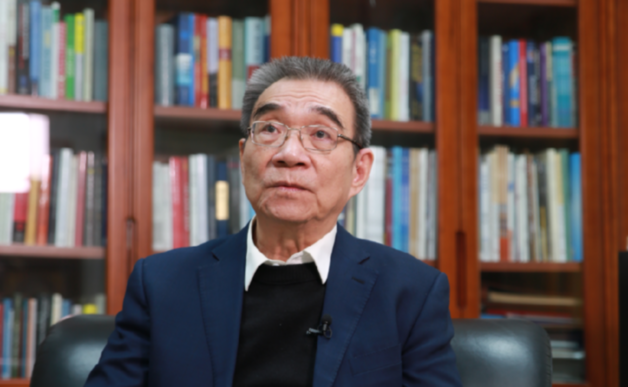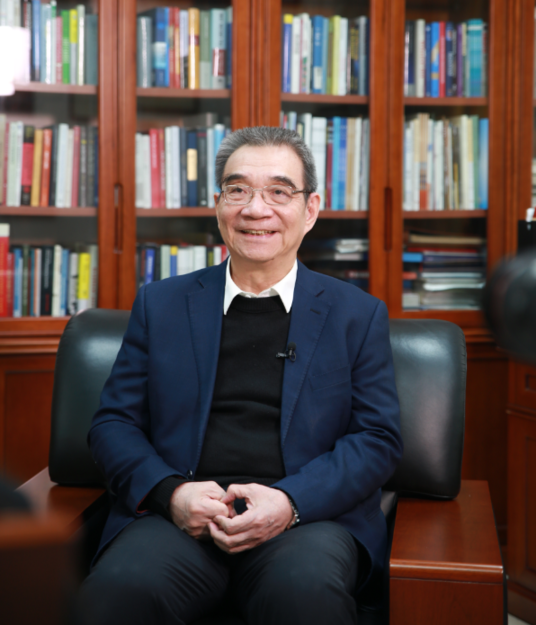
As Lin Yifu observes, developing countries should have more confidence in their own choice for economic development and institutional design. While learning from others is a comprehensibly inevitable start, they should then find the way that best suits their own national realities, rather than simply copying every detail from that of developed countries.
By Yin Jie
A Pekingese pug and a Tibetan mastiff are about the same size when they are puppies, and they look very similar, too. However, a young Pekingese pug would never grow into a huge Tibetan mastiff regardless of how hard its master tries, while a young Tibetan mastiff, when fed with food that is only enough for a little Pekingese pug, would be under-nourished and then grow up to the size of a small pug: potential is the very factor that makes the difference.
When talking about the developmental potential of different countries or regions, Lin would often use this rather humorous metaphor.
From 1978 to 2020, the average annual growth rate of China’s economy was as high as 9.2%. No other country or region in human history has maintained such a high growth rate for such a long period of time. However, the western world has never stopped talking down China’s development, with different reasons almost every year. The current popular saying is that China doesn’t have much developmental potential any more.
Lin said: “some people argue that China has developed too fast in the past 40 years, which is an abnormal case and will eventually return to a normal track while some others say that China’s aging population will put negative impact on its economic growth. These people think that China will follow the step of countries like Germany and Japan: on purchasing power parity, after China’s per capita GDP reaches 14,000 USD, its GDP growth rate will significantly drop to as low as 3%-4%.”
However, as Member of the Standing Committee of the CPPCC and Deputy Director of the CPPCC Economic Affairs Committee, Lin believes that these seemingly convincing studies cannot actually hold water.

Never Underestimate China’s Growth Potential
At the 5th Session of the 13th National Committee of the CPPCC, Lin said in a video interview that in order to achieve high-quality development, China must continue the innovation with better industrial technologies. In this process, China needs to give full play to its comparative advantage, which can be categorized into two kinds:
Advantage as a latecomer: China’s per capita income is now standing in front of the threshold of high-income countries, but there is still a considerable gap to reach that of countries in Europe and the United States. The existence of such a gap means there is huge potential, so long as China can learn, absorb, internalize and renovate. The cost of innovation in this way is relatively small, also with less risks.
Advantage for overtaking in new sectors and tracks: when it comes to new economic forms relying on human capital investment as the mainstay with short R&D cycles, China and developed countries actually stand on the same starting line. Thankfully, China has a full coverage of industries with large human capital, huge domestic demand and complete supporting facilities. With these distinctive advantages, the number of Chinese unicorn companies has ranked first or second in the world in recent years, which is a good manifestation for such an advantage.
In the future, in promoting technological innovation, industrial upgrading and structural transformation, we must make good use of these two advantages mentioned above. Apart from innovation, China also needs to make a balance regarding coordination, greenness, openness and sharing, so as to achieve high-quality development in the future.
Statistics show that in more than 100 years in the past, the normal economic growth rate by developed countries was around 3%-3.5% per year which is far lower than that in China and other well-performing developing countries.
According to Lin’s explanation, developed countries boast the most advanced technologies and the most full-fledged industries around the world, but this also means that they need to bear the full R&D cost for technological innovation and industrial upgrading, with large investment, high risk and yet slow speed of making breakthroughs. If developing countries know how to take the advantage as latecomers, they can obtain technological innovation and industrial upgrading at a lower cost and with less risk, therefore gaining faster development than developed countries.
In this case, China’s potential for development depends not only on current per capita income, but also on the industrial and technological gap between China and developed countries, especially the United States.
On purchasing power parity, Germany’s per capita GDP reached 14,000 USD in 1971, 72.4% of that by the US in that year; Japan’s per capita GDP reached 14,000 USD in 1975, 69.7% of that by the US in that year; China’s per capita GDP reached 14,000 USD in 2019, only 22.6% of that by the US in that year. By comparison, Germany’s per capita GDP reached 22.6% of the United States in 1946, Japan reached in 1956, and South Korea reached in 1985!
From 1946 to 1962, the average growth rate of Germany’s economy was 9.4%; from 1956 to 1972, the average growth rate of the Japan’s economy was 9.6%; from 1985 to 2001, South Korea’s average economic growth rate was still as high as 9.0%, even though it suffered from the Asian financial crisis with one year of negative growth.
Based on these facts in the past, there should be growth potential of about 9% in the next 16 years for China, anticipated by Lin.
Honestly speaking, Germany, Japan and South Korea did not have an aging population (like what China faces now), whose biggest impact is the poor growth in population and labor force. During the periods above, Germany, Japan and South Korea recorded population growth rates of 0.8%, 1.0% and 0.9% respectively. The average annual economic growth rates brought by the increase in labor productivity were 8.6%, 8.6% and 8.1% respectively.
Therefore, taking aging into account, China should still have an average annual growth potential of 8% before 2035. In addition, problems such as the shortage of labor force can somehow be addressed by postponing the retirement age and empowering the workers in both educational and professional terms.
According to Lin, on the basis of the growth potential at 8%, taking into consideration the efforts to solve environmental pollution, urban-rural disparity and technological bottlenecks, it is entirely possible for China to enjoy high-quality development with an annual growth of around 6%. According to this forecast, China will become a high-income country by 2025. At present, the population of high-income countries only accounts for 16% of the world’s total. If China becomes a high-income country, this number will more than double.

The mind decides the way
As Lin observes, developing countries should have more confidence in their own choice for economic development and institutional design. While learning from others is a comprehensibly inevitable start, they should then find the way that best suits their own national realities, rather than simply copying every detail from that of developed countries.
“Most developing countries used to be colonies or semi-colonies, so they generally believe that learning the developmental models of developed countries will make them prosperous and strong, while the results are often far behind expected. After the World War II, no developing country succeeded by simply copying the theories or practices of developed countries. Different from that, China has chosen a pragmatic way of development for its economic rise that takes national realities and comparative advantages into consideration, and then choose what’s good for itself. Instead of imitating what western countries are good at, China intends to start from scratch and achieve industrial upgrade in a step-by-step manner from low-end to high-end. This best describes the idea that the mind decides the way,” Lin said.
The rise of China has also changed the economic and even the political landscape of the world. Lin often uses this example to illustrate his idea:
In 1900, when the eight most powerful industrialized countries in the world formed the Eight-Power Allied Forces to invade China, their combined GDP (on purchasing power parity) accounted for 50.4% of the world’s total. By 2000, there was still a Group of Eight (G8) in the world with a combined GDP accounting for 47% of the world’s total. That is to say, after a century, the GDP share by the top 8 industrialized countries in the world has dropped by only 3.4%. After three or four generations with great efforts, developing countries have made little progress in changing their economic status.
However, by 2018, the GDP by the G8 countries accounted for 34.7% of the world’s total, while the dominant force for global governance has also changed from the G8 to the G20.
Adjusted by purchasing power parity, China’s GDP surpassed that of the United States in 2014 and became the world’s largest. The anxiety by the United States on losing its status as the world leader has generated not only great tension between China and itself, but also huge uncertainty to the world. The raging pandemic of COVID-19 around the world has further accelerate the change in strength between China and the United States.
GLOBAL PEOPLE: As the pandemic has plagued the world for the third year, what major difficulties do you think the Chinese economy will face this year?
Lin: The Central Economic Work Conference has made it very clear that China’s economy now faces pressure from three aspects: shrinking demand, shocks on supply and weakening expectation. I think the biggest difficulty is in third one: there are considerable external factors that we cannot control for shrinking market demand while the shock on supply, mainly by the spreading COVID-19 pandemic, is neither within our control. However, we can do something about market expectation!
There is still a huge room for growth for China’s economy for both technological innovation and industrial upgrading. At the same time, China’s savings rate accounts for about 45% of GDP while and the government debt ratio is relatively low, which means there are abundant resources for financial investment. As long as there is confidence in the market, investment will increase, new jobs will be created, the economy will grow, household incomes will rise and consumption will subsequently be boosted. At this moment, therefore, the most important thing is to put the pandemic under control, which is directly vital for fostering market confidence. With confidence in place, we’d then make good use of resources and seize investment opportunities, so as to enjoy stable growth.

In February 2022, Lin Yifu was exclusively interviewed by GLOBAL PEOPLE in Beijing. (Photo by Song Yuxin)
GLOBAL PEOPLE: With the spread of the Omicron variant of COVID-19, what further changes will happen for the global economic landscape?
Lin Yifu: First of all, after the outbreak of COVID-19, China's economic position in the world has further risen. In 2019, China’s total GDP was 67% of that of the United States, 70% of the US GDP in 2020, and 77% in 2021. It can be seen how fast the speed is at which the gap between China and the US is narrowing.
As for the Omicron strain, the speed of spreading is indeed very fast. Developed countries have made a wide-coverage of vaccination, so their economic difficulties would probably be mitigated in this year. However, in developing countries (excluding China), the proportion of vaccination is quite low, and there may be multiple waves of pandemic resurgence, putting further obstacles for their economic growth. Global economy in 2022 may be featured by a diverging world, with developed countries starting to recover and developing countries still generally lagging behind.

Using Comparative Advantages is good for Common Prosperity
GLOBAL PEOPLE: Do you think the center of the world economy is turning to Asia?
Lin Yifu: This is obviously and absolutely true.
China is the world’s second largest economy in terms of market exchange rates and the world’s largest in purchasing power parity terms. Japan is the third largest economy in the world, and South Korea is also among the top 10. Although India is still a developing country, it has a large population and a huge economic scale. After the Industrial Revolution, the center of the world economy was originally in Europe, but was then moved to the United States, and now to Asia.
GLOBAL PEOPLE: The United States has tried multiple ways to contain China’s development in recent years. Since the US boasts great technological and financial advantages, why did all its efforts fail?
Lin Yifu: The United States, as the world’s only superpower, leverages its political, economic, military, technological and other advantages to restrict China’s development in order to maintain its hegemony. This is not a win-win cooperation but a double lose for China and the US. Indeed, the high-tech industry requires an immense amount of investment for R&D breakthroughs, but it is the size of its market that determines how much such a breakthrough can bring.
China is the largest market in the world, so many high-tech companies in the United States can enjoy high profits if they sell their products to China. Otherwise, it will be so hard for them to find another place with such business opportunities. As high-tech products are frequently replaced by newer generations, once profitability goes low, investment will be insufficient and, consequently, their leading position will soon be lost.
Therefore, most American companies are willing to cooperate with China. In particular, since Europe and Japan also have their own high-tech enterprises like those in the US: if American companies are banned from selling products in China’s market for the sake of maintaining the US hegemony, counterparts from other countries will be more than glad to replace their market share in China.
In addition, for a few bottleneck technologies (like lithography machines) that only the United States has, China can also begin its own development with country-wide talents and inputs. According to past experience, as long as China can independently produce something with its own research breakthrough, the price of such product will drop significantly.
Therefore, the United States is likely to lift a stone and hit its own foot. As long as we keep our mind, analyze clearly where our advantages and disadvantages lie, which technologies can be used in the international market, and which technologies must be controlled by ourselves, and concentrate our efforts to solve problems one after another, I believe China will ultimately achieve its rejuvenation despite of so much noise along the journey and bumpers on the road.
GLOBAL PEOPLE: The next goal by China is to achieve common prosperity. How should we formulate different policies according to the changing economic realities in each region across the country?
Lin Yifu: Common prosperity is indeed a highly lofty ideal.

In October 2021, people put their harvest in the shape of words “Common Prosperity and Beautiful Home” at the ancient village of Daciyan Town at Jiande City in Zhejiang Province
We hope to make the pie bigger and bigger, and we also hope to divide the pie more and more fairly. This is the goal commonly pursued by mankind but, as for the approach to achieve this target, the key is to develop according to the comparative advantage by each place, so that in the first round of income distribution, both fairness and efficiency can be achieved.
For regions with relatively backward economies, it is usually necessary to foster labor-intensive industries at the early stage to create more employment opportunities and increase the income by workers.
With the development of economy, the labor force will change from relatively rich to relatively short, and the capital will change from relatively short to relatively rich. Wages will rise very fast. As we all know, a large part of the income of the rich comes from capital, while the majority of the income of the poor comes from labor. If the wage increases very fast, it will be more beneficial for low-income people.
If the first round of income distribution can achieve both fairness and efficiency, the economy will develop faster and the government will have more fiscal revenue. As the corresponding industries can give full play to their comparative advantages, enterprises will have strong self-reliance and the independent ability to survive without unnecessary subsidies from the government. In this case, the second round of income distribution will be even more efficient, particularly for the investment in education or for the spending on helping the vulnerable or the jobless.
On this basis, if we can provide tax incentives for enterprises doing social welfare, it will also be conducive to the third income distribution. Therefore, in order to achieve common prosperity, it is best to develop according to comparative advantages, realize the unity of fairness and efficiency in the primary distribution, and use tax policies for secondary distribution and encourage the first rich groups to do the third distribution of social public welfare. Common prosperity can be achieved in all parts of the country.